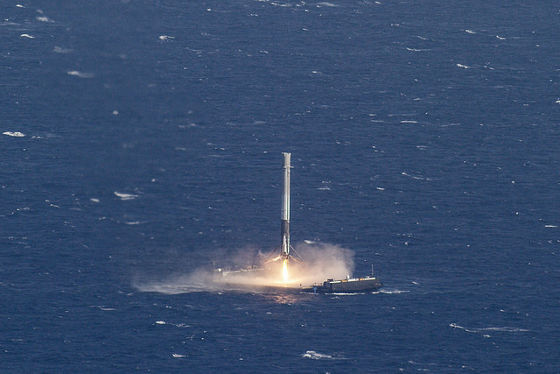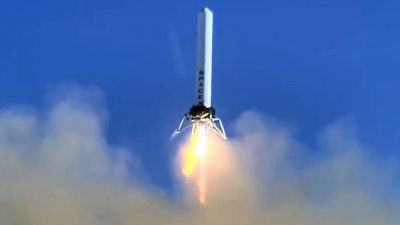An attempt to catch a falling rocket booster in the air after launch using a helicopter

The IEEE Spectrum, run by the Institute of
A Helicopter Will Try to Catch a Rocket Booster in Midair --IEEE Spectrum
https://spectrum.ieee.org/rocket-booster-rocket-lab
There are two rocket launch pads along the New Zealand coast. One of them is Rocket Lab , based in Virginia, USA, which is a dedicated launch pad for launching ' Electron ,' a reusable rocket for carrying small satellites into space. The Earth's gravity is so strong that two-thirds of the rockets that carry spacecraft into space are used to leave the atmosphere. And, the conventional rocket becomes garbage that can never be used again in about 3 minutes after launch.
Making this rocket reusable has been a dream for aerospace engineers since the early days of space exploration, as it saves a lot of money and resources. Reusable rocket is a technology that has already been realized, and Falcon 9 developed by Elon Musk's space development company SpaceX succeeded in recovering the rocket after launch in 2016.
SpaceX 'Falcon 9' rocket finally succeeded in vertical return to the drone ship, summary of the movie etc. --GIGAZINE

Since then, the use of Falcon 9 has become widespread, and in 2020 it will also be used to launch the first American civilian spacecraft.
NASA and SpaceX Launch Movie & Photo Summary of America's First Private Spacecraft-GIGAZINE

Whereas Falcon 9 uses its own booster to bring the rocket back to the ground on its own, Rocket Lab attempts a different approach to recovering the rocket. Rocket Lab plans to launch using Electron on April 22, 2022 local time, which will carry 34 commercial satellites. The rocket booster Electron used for launch is a multi-stage rocket , and the first stage engine usually falls into the Pacific Ocean, but this first stage engine is used in the air using a helicopter. It is planned to be collected.
Rocket Lab engineer Morgan Bailly said of an attempt to retrieve a rocket in the air using a helicopter: 'It's very complicated and you need to put the helicopter in the right place. You need to make accurate predictions, and you also need to slow down enough to recover the falling engine. ' According to Mr. Bailly, various technologies have been individually verified in preparation for an attempt to recover the engine using this helicopter, and it seems that the challenge of combining these will be 'this recovery'.
Electron is a launch vehicle with a total length of 18 meters, and the length of the first stage engine is about 12 meters. The launch of Electron will take place on April 19, 2022 local time on the Mahia Peninsula, New Zealand. Electron will fly to a height of 520km from the ground, but the first stage engine will be separated at an altitude of 70km and will fall to the sea. The helicopter called Sikorsky S-92 , which has been specially customized, is in charge of recovery. The Sikorsky S-92 is a large twin-engine helicopter that is active in oil and gas transportation and search and rescue activities.
This helicopter? We're going to use it to pluck Electron's first stage from the sky as it returns to Earth under a parachute during our next mission, a commercial rideshare launch scheduled for lift-off in the second half of April .??? ?????????
— Rocket Lab (@RocketLab) April 5, 2022
Full details: https://t.co/RcRJMigiVz pic.twitter.com/Hv9987DSTo
Rocket Lab has already established itself as a space development company, and Electron has sold 26 units so far. According to Rocket Lab, the company has launched 112 satellites, many of which are relatively inexpensive small satellites. 'Currently, only two companies, SpaceX and Rocket Lab, are carrying satellites into satellite orbit,' said Chad Anderson, CEO of Space Capital, which funds space exploration companies.
Electron has been specially heat-treated to protect the engine from falling at a speed of 8300km / h. In addition, the engine that falls to the ground will reach a maximum of 2400 degrees by aerodynamic heating . At an altitude of 13km, the small parachute mounted on Electron's first stage engine will be deployed, and at an altitude of 6km, the main parachute will also open. The two parachutes slow down the engine significantly, reducing the fall speed to 36 km / h.
The Sikorsky S-92 recovers the engine by hooking a key rope on the parachute.

If parts of a reusable rocket fall into the sea, the engine will need to be cleaned before it can be reused, which is costly and time consuming. Therefore, if the engine can be recovered in the air, it will be possible to save the time and cost for refurbishment, which will lead to the realization of a more feasible reusable rocket.
Related Posts:
in Hardware, Posted by logu_ii







